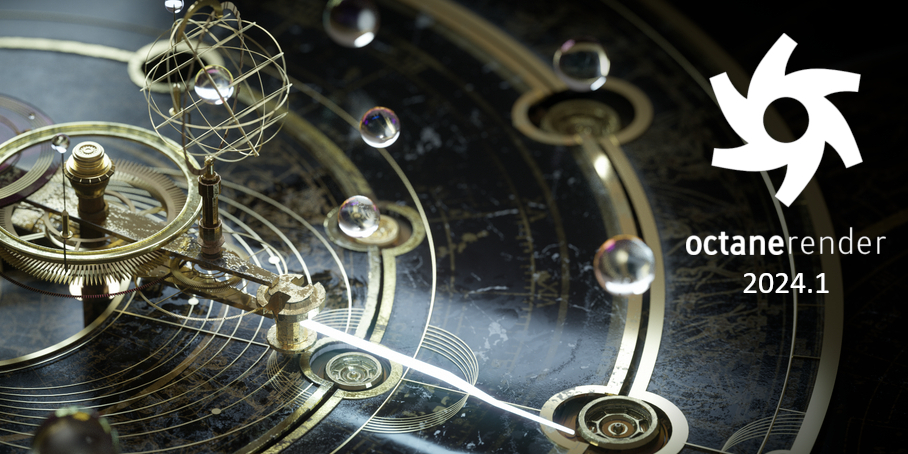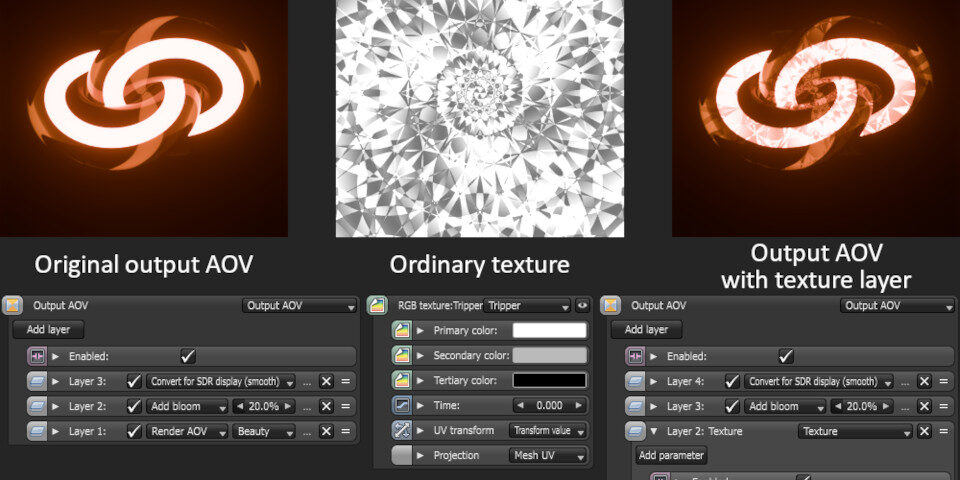Otoy releases first public preview of OctaneRender 2024.1

Otoy has released the first public preview of OctaneRender 2024.1, the next major version of the GPU production renderer.
The release introduces a new geometry pipeline, improving ray tracing performance and finally making it possible to mix Macs with Windows and Linux machines in render networks.
Other changes include new options for post-processing AOVs, and new denoising nodes based on the Open Image Denoise framework.
Multi-platform network rendering finally made possible by new geometry pipeline
The key change in OctaneRender 2024.1 is the new geometry pipeline – which, among other things, makes it possible to mix Windows, Linux and macOS machines in a render network.
Currently, Otoy supports CUDA in the Windows and Linux versions of OctaneRender, and Metal in Octane X, the edition for Apple devices.
The firm previously used different memory layouts for geometry data on CUDA and Metal, making it impossible to use both Windows/Linux machines and Macs in the same network.
OctaneRender 2024.1 unifies the geometry data layouts, making it possible to do mixed-platform network rendering.
Otoy has temporarily enabled network rendering in the free Prime edition of Octane X to make it easier for subscribers to test the new functionality.
Improved ray tracing performance on all platforms
In addition, with the new geometry pipeline, Otoy has “commit[ted] fully to hardware ray tracing”.
OctaneRender 2024.1 uses the RT cores in NVIDIA GPUs for all mesh primitives, including hair, spheres and displacement triangles, improving rendering performance.
In the case of the standard test scene shown in this forum post, render time is reduced by around 20% when compared to the previous release, although Otoy says that in “extreme” cases with heavy motion blur, the reduction can be as high as 80%.
The software is also being optimized for the ray tracing hardware in Apple’s new M3 processors, resulting in “2x to 12x(!) speed gains in heavily instanced scenes”.

New options for post-processing and denoising AOVs
Other changes include a new ‘Texture’ Output AOV layer node in the AOV Compositor, which can be used to composite textures into render passes on the fly, as shown above.
As well as image files, it works with node trees and OSL shaders, making it possible to perform more complex tasks: suggested use cases include combining and color-correcting light passes.
The update also adds new denoise AOV nodes adapted from the Open Image Denoise (OIDN) framework.
They are supported on both CPU and GPU, GPU support having been added in OIDN 2 earlier this year, and can accessed from both the Imager node and the AOV Compositor.
That makes it possible to create “powerful and granular denoising filters”, including per-light denoising, and OSL-driven denoising effects.
More features due to be added before the stable release
Other features due to be added to OctaneRender 2024.1 before the final stable release include native MaterialX support, new AI assistant OctaneGPT, and support for light field baking.
According to Otoy, Brigade temporal denoising and meshlet texture streaming, both annnounced last year for Octane 2023, are also now in “active development” for 2024.1.
You can read more about the current Octane 2024 roadmap in this story.
Price and system requirements
OctaneRender 2024.1 is currently in alpha. Otoy hasn’t announced a final release date yet, but other recent updates have taken 6-12 months to get from the initial preview to a stable release.
The current stable version, OctaneRender 2023.1, is compatible with 64-bit Windows 7+ and Linux, and requires a CUDA 10-capable NVIDIA GPU.
The Apple edition, Octane X 2023.1, is compatible with macOS 14+ on Macs with Apple M1 and later processors, and with iOS 17+ and iPadOS 17+ on devices with A12 Bionic and later chips.
The software is rental-only, via Otoy’s Studio+ subscriptions, which cost €23.95/month, and which include integration plugins for 21 DCC applications, plus a range of third-party software.
Otoy also provides free ‘Prime’ editions of both OctaneRender and Octane X, which are limited to rendering on a single GPU, and which come with a smaller set of DCC integration plugins.
Read a full list of new features in OctaneRender 2024.1 on Otoy’s forum
Have your say on this story by following CG Channel on Facebook, Instagram and X (formerly Twitter). As well as being able to comment on stories, followers of our social media accounts can see videos we don’t post on the site itself, including making-ofs for the latest VFX movies, animations, games cinematics and motion graphics projects.
